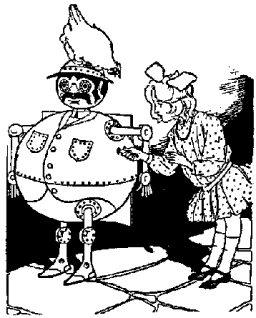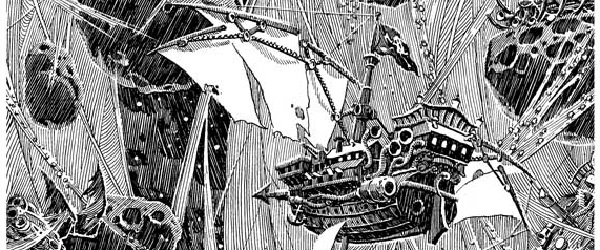 |
| Machinists preparing a rocket for Thomas Edison. |
Science Fiction in 19th and early 20th century was not enormously successful, and was often dominated by European writers, however there was plenty of homegrown talent that greatly influenced the genre.
In the Pulp Age setting (which has a number of Steampunk elements in it) America is front and center in the affairs of the world, churning out adventurers, industrialist inventors, and all manner of wild gadgetry. And so I will be incorporating the concepts of American writers of wild adventure stories and Edisonade elements.
 A SHORT LIST OF AUTHORS
A SHORT LIST OF AUTHORSBelow is a list of some American authors whose work could be considered Steampunk in many regards, and excellent examples of early Science Fiction. The science involved ran the whole gamut of plausibility and implausibility, but were thoroughly American in caste.
Frank L. Baum
Everyone has heard of The Wonderful Wizard of Oz, but this knowledge rarely goes beyond the 1939 film. As fun as that classic was, it hardly represents the weird and wonderful world that was churned out of this mans mind. In the Oz Books, we find all manner of strange creatures, more than a few of whom are mechanical beings of one kind or another. Though not Steampunk per se, the strange devices found throughout Oz are excellent fodder for inventions. If nothing else, the Oz books would be something that Pulp Age Adventurers would be aware of and can supply some useful flavour text to an adventure of backstory.
Edward Bellamy
Edgar Rice Burroughs
Though known primarily for his Tarzan novels (and the many sad movie attempts of this character), Edgar Rice Burroughs initially came on the scene with Under the Moons of Mars (1912) which inaugurated the Barsoom series (ala John Carter of Mars). These novels, along with the primordial strangeness of the Hollow Earth of Pelucidar and the Amtor (Venus) novels, make his work IDEAL for Steampunk adventures. The Land That Time Forgot is another gem worth digging up for lovers of wild implausible adventures, this one set in WWI. Not only are the works of Burroughs excellent for tidbits for GMs, but are damn fun to read. I recommend them highly!
Charlotte Gilman
The efforts of the early feminists in America are certainly noteworthy and should be required reading in all schools (but are NOT). Charlotte Gilman was a powerful voice during her lifetime (1860-1935) being a novelist, writer of short stories, poetry, and nonfiction, and a lecturer for social reform.Though perhaps not Steampunk, she wrote a novel involving weird bio-science called Herland. Herland is a utopian novel from 1915, written by feminist Charlotte Perkins Gilman. The book describes an isolated society composed entirely of women, who reproduce via parthenogenesis (asexual reproduction). The result is an ideal social order: free of war, conflict, and domination.
Edward Everett Hale
 Edward Everett Hale was an American author, historian and Unitarian minister. Though primarily known as a Historian, he also wrote an excellent short story called The Brick Moon, published serially in The Atlantic Monthly starting in 1869. It describes the construction and launch into orbit of a sphere, 200 ft. in diameter, built of bricks. It is intended as a navigational aid, but is accidentally launched with people aboard. They survive, and so the story also provides the first known fictional description of a space station.
Edward Everett Hale was an American author, historian and Unitarian minister. Though primarily known as a Historian, he also wrote an excellent short story called The Brick Moon, published serially in The Atlantic Monthly starting in 1869. It describes the construction and launch into orbit of a sphere, 200 ft. in diameter, built of bricks. It is intended as a navigational aid, but is accidentally launched with people aboard. They survive, and so the story also provides the first known fictional description of a space station.Considered a minor author today, Will Harben was one of the most popular novelists in America during the first two decades of the twentieth century. In 1894 he wrote Land of the Changing Sun, his only science fiction novel. The story concerns a voyage to the center of the earth where they find a technologically advanced civilization. He incorporates number of interesting concepts such as super-foods in the form of a liquor and wireless power much like that proposed by Tesla. The book is a bit dense (being Victorian in language) but very interesting in concept.
Richard Adams Locke
Richard Adams Locke was a reporter who was working for The Sun when he wrote "The Great Moon Hoax" in 1835 under the false name of Sir John Herschel (a widely respected astronomer). The Great Moon Hoax was a series of articles about the supposed discovery of life and even civilization on the Moon.
The articles described fantastic animals on the Moon, including bison, goats, unicorns, bipedal tail-less beavers and bat-like winged humanoids ("Vespertilio-homo") who built temples. There were trees, oceans and beaches. These discoveries were supposedly made with "an immense telescope of an entirely new principle."
Herschel was initially amused by the hoax, noting that his own real observations could never be as exciting. He became annoyed later when he had to answer questions from people who believed the hoax was serious.
Though not technically a Steampunk tale, the Moon Hoax articles are excellent fodder for adventure. In most Steampunk tales of the Moon there certainly is life.
Edward Page Mitchell (An American H.G. Wells)
Edward Page Mitchell (1852–1927) was an American editorial and short story writer for The Sun, a daily newspaper in New York City. Mitchell was a prolific writer of Steampunk/Science Fiction, and was more than a little ahead of European contemporaries. Mitchell wrote fiction about a man rendered invisible by scientific means ("The Crystal Man", published in 1881) before H.G. Wells's The Invisible Man, wrote about a time-travel machine ("The Clock that Went Backward") before Wells's The Time Machine, wrote about faster-than-light travel ("The Tachypomp"; now perhaps his best-known work) in 1874, a thinking computer and a cyborg in 1879 ("The Ablest Man in the World"), and also wrote the earliest known stories about matter transmission or teleportation ("The Man without a Body", 1877) and a superior mutant ("Old Squids and Little Speller"). "Exchanging Their Souls" (1877) is one of the earliest fictional accounts of mind transfer.
A collection of his works can be found here.
Luis Senarens
Luis was an American dime novel writer specializing in science fiction, once called "the American Jules Verne". He grew up in a Cuban-American family in Brooklyn. Senarens wrote elaborate and entertaining "inventor" themed stories incorporating all manner of wild devices. Helicopter like flying "ironclads" are widely represented in his work, and predated all other such fictional devizes by a wide margin. If you would like to read up on his work the Reade Family and particularly Boilerplate are presently available in print. For a free view of his work the book Jack Wright and His Electric Stagecoach is a good place to start.
Garrett Putman Serviss
Garrett Putnam Serviss was an American astronomer, popularizer of astronomy, and early science fiction writer. His scientific papers are very interesting in their own right, and present some very interesting thoughts on the possibilities of life within our own solar system. However on the concept of Steampunk, it would be hard to do better than Edison's Conquest of Mars. In this novel, a force from Earth, composed of troops from around the world (and under the leadership of Thomas Edison) set out in Earth-made spaceships to attack Mars. This is in retaliation of the Martian assault in H.G. Wells War of The Worlds.
The Martians in this version are not like the squid-like Martians described in H.G. Wells's story. These Martians are more humanoid with arms, legs and an enormous head with projector-like eyes and bad looking faces. When they rise, they are 15 feet high (4.572 meters). However this is only the male, for the species exhibits sexual dimorphism. To Earthlings, they appear unpleasant. The Martian women, however, are (of course) graceful and beautiful.
The book contains some notable "firsts" in science fiction: alien abductions, spacesuits (called "air-tight suits"), aliens building the Pyramids, space battles, oxygen pills, asteroid mining and disintegrator rays. Steampunk Space Opera is a wonderful concept.
George Tucker
George Tucker was a United States attorney, author, educator and politician. His literary works include the first fiction of colonial life in Virginia and a second which is one of America's earliest science fictions, A Voyage to the Moon. In this novel we see the first known depiction of antigravity, as well as some novel views of utopian societies in the denizens of the Moon. The novel is more of a review of utopian concepts rather than speculations on science, but it is interesting nonetheless.










